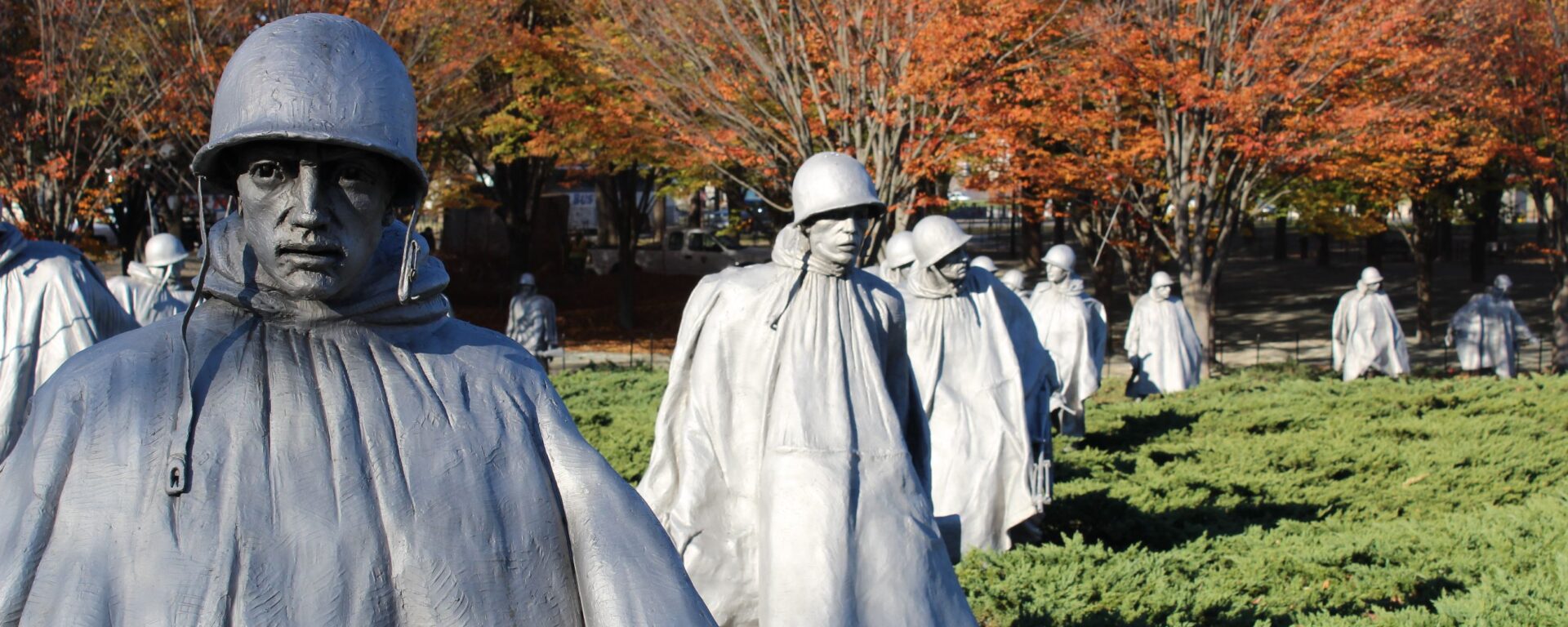“The Korean War: No Victors, No Vanquished.”
South and east of the Lincoln Memorial, next to Daniel French Dr. and Independence Ave., is one of the most well-known war memorials in Washington, D.C. Few memorials are imbued with as much humanity as the Korean War Veterans Memorial. Nineteen stainless steel soldiers march in formation in a triangular park. To their south is a wall of black granite with photographic images sandblasted onto its surface. At the eastern end of the park is the Pool of Remembrance. On the northern edge is the United Nations Wall, listing the 22 UN member nations that sent soldiers to Korea.

The memorial was dedicated July 27, 1995, on the 42nd anniversary of the Korean Armistice Agreement. President Bill Clinton and the President of the Republic of Korea, Kim Young-sam, presided over the ceremony that was attended by more than 100,000.
The final cost of the memorial was $18 million, and the soldiers – collectively titled “The Column” – were sculpted by Frank Gaylord. The nineteen soldiers are each unique and represent not only the 4 branches of the military, but also the ethnic diversity of the American forces. The granite wall to the south is highly polished to reflect the soldiers, giving a picture of 38 soldiers, calling to mind both the 38 months of the war and the 38th parallel that had divided the Korean peninsula prior to the war.

History is unclear on who fired the first shots of the Korean War, but on June 25, 1950, the North Korean army crossed the 38th parallel into South Korean territory. President Harry S. Truman was determined to intervene in Korea, saying “If the Communists were permitted to force their way into the Republic of Korea without opposition from the free world, no small nation would have the courage to resist threat and aggression by stronger Communist neighbors.”
Initially, the combined American and U.N. forces were under-equipped to fight. Truman had cut the defense budget after WWII and couldn’t even enforce a naval blockade of North Korean forces. By September they had been pushed to the southeastern coast of the peninsula. But while the ground forces had been forced into a corner, the Air Force had been busy destroying the infrastructure that the North Korean army had captured. The North Korean forces had over-extended themselves, and by the end of the month the South Korean government had been restored and Seoul had been recaptured.

Unfortunately, the U.N. forces pursued the North Korean army past the 38th parallel on October 1. This caused the Chinese to believe that if U.N. forces were to take the Korean peninsula, they would come for Chinese territory next. Although the U.N. forces quickly took most of the peninsula, the victories were short-lived. On October 25, the Chinese deployed 200,000 troops into Korea and by 1951, U.N. forces were pushed out of Seoul and south of the 38th parallel. The city would be retaken in March but by June the opposing armies would be fought to a stand-still.

For the next two years, little territory would be gained or lost. In July 1953 the two sides would sign an armistice that would “insure a complete cessation of hostilities and of all acts of armed force in Korea until a final peaceful settlement is achieved.” No peace settlement has yet been achieved. Over 200,000 U.N. soldiers died or went missing during the conflict and the Chinese and North Koreans suffered at least 350,000 dead or missing (some sources estimate more than 750,000). The Korean government estimates that more than 2 million civilians died as well.

Resources used for this article:
https://en.wikipedia.org/wiki/Korean_War_Veterans_Memorial
http://www.koreanwarvetsmemorial.org/memorial
https://en.wikipedia.org/wiki/Korean_War
https://en.wikipedia.org/wiki/Korean_Armistice_Agreement
